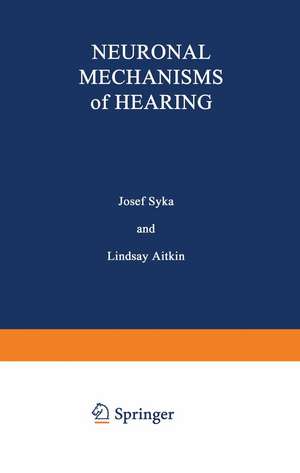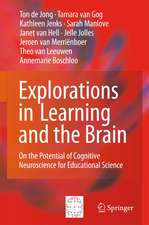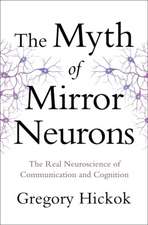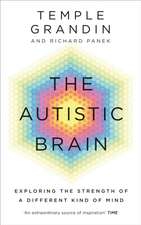Neuronal Mechanisms of Hearing
Editat de Lindsay Aitkinen Limba Engleză Paperback – 22 mar 2012
Preț: 403.91 lei
Nou
Puncte Express: 606
Preț estimativ în valută:
77.31€ • 84.01$ • 64.98£
77.31€ • 84.01$ • 64.98£
Carte tipărită la comandă
Livrare economică 21 aprilie-05 mai
Preluare comenzi: 021 569.72.76
Specificații
ISBN-13: 9781468439106
ISBN-10: 1468439103
Pagini: 460
Ilustrații: XII, 444 p.
Dimensiuni: 178 x 254 x 24 mm
Greutate: 0.79 kg
Ediția:Softcover reprint of the original 1st ed. 1981
Editura: Springer Us
Colecția Springer
Locul publicării:New York, NY, United States
ISBN-10: 1468439103
Pagini: 460
Ilustrații: XII, 444 p.
Dimensiuni: 178 x 254 x 24 mm
Greutate: 0.79 kg
Ediția:Softcover reprint of the original 1st ed. 1981
Editura: Springer Us
Colecția Springer
Locul publicării:New York, NY, United States
Public țintă
ResearchCuprins
Session I. Cochlear mechanisms A.- The Responses of Hair Cells to Low Frequency Tones and Their Relationship to the Extracellular Receptor Potentials and Sound Pressure Level in the Guinea Pig Cochlea.- Some Comparative Aspects of a Cochlear Mechanism.- The Parasympathetic Innervation of the Inner Ear and the Problem of Cochlear Efferents: Enzyme and Autoradiographic Studies.- Adaptation and Dynamic Response Occurring at Hair Cell — Afferent Fiber Synapse.- Phase Versus Frequency Plots from Caiman Primary Auditory Fibres: Is There a Travelling Wave?.- Session II. Cochlear Mechanisms B.- The Dynamics of pO2-Changes in the Perilymphatic Perfusate of the Guinea Pig Cochlea Depending on the Metabolism.- Analytical Studies on Biochemistry and Physiology of Perilymph (Guinea Pig).- Distribution of Microphonic Potentials in the Four Turns of the Guinea Pig Cochlea.- Session III. Coding in the Auditory Nerve and Cochlear Nucleus.- The Dynamic Range Problem: Place and Time Coding at the Level of Cochlear Nerve and Nucleus.- Coding of Complex Sounds in the Auditory Nervous System.- On Predicting the Response of Auditory Nerve Fibers to Complex Tones.- Effects of Masking Noise on the Representation of Vowel Spectra in the Auditory Nerve.- Neuronal Circuits in the Dorsal Cochlear Nucleus.- The Internal Organization of the Dorsal Cochlear Nucleus.- Session IV. Central Auditory Mechanisms A.- Functional Organization of the Inferior Colliculus.- Integration and Segregation of Input to the Cat Inferior Colliculus.- Some Facets of the Organization of the Principal Division of the Cat Medial Geniculate Body.- Functional Organization of the Medial Geniculate Body Studied by Simultaneous Recordings of Single Unit Pairs.- Possibilities of Recording Multiunit Activity in the AuditoryPathway.- Poststimulatory Effects in the Medial Geniculate Body of Guinea Pigs.- How Biosonar Information Is Represented in the Bat Cerebral Cortex.- Three-Dimensional Study of Evoked Field Potentials in the Auditory Cortex of the Cat.- Differential Diagnosis of Hearing Disorders-Clinical Findings Contributing to Information Processing in the Auditory Pathway.- Session V. Central Auditory Mechanisms B.- Binaural Interaction in the Cat Inferior Colliculus: Comparison of the Physiological Data with a Computer Simulated Model.- Coding Properties of the Different Nuclei of the Cat’s Medial Geniculate Body.- Interaural Delay Sensitive Units in the MGB of the Cat.- Temporal Information in the Medial Geniculate Body.- Some Investigation of Acoustical Evoked Potentials from Peripheral and Central Structures of the Auditory Pathway in Rabbits.- Session VI. Auditory Localization.- Anatomical-Behavioral Analyses of Hindbrain Sound Localization Mechanisms.- Effects of Unilateral Ablation of Anteroventral Cochlear Nucleus on Localization of Sound in Space.- Binaural Interaction Models and Mechanisms.- Psychophysical and Neurophysiological Data on the Sound Source Perception.- Session VII. Neural Coding of Speech and Complex Stimuli.- Information Processing in Neuronal Populations of the Human Brain during Learning of Verbal Signals.- A Comparison of the Responses Evoked by Artificial Stimuli and Vocalizations in the Inferior Colliculus of Squirrel Monkeys.- Acoustic Properties of Central Auditory Pathway Neurons during Phonation in the Squirrel Monkey.- Selectivity of Auditory Neurons for Vowels and Consonants in the Forebrain of the Mynah Bird.- Some Aspects of Functional Organization of the Auditory Neostriatum (Field L) in the Guinea Fowl.- 14-C-Deoxyglucose Labeling of theAuditory Neostriatum in Young and Adult Guinea Fowl.- Integration of Voco-Auditory Centers in Song Birds.- Response Properties and Spike Waveforms of Single Units in the Torus Semicircularis of the Grassfrog (Rana Temporaria) as Related to Recording Site.- Coding of Amplitude-Modulated Sounds in the Midbrain Auditory Region of the Frog.- Session VIII. Deprivation and Developmental Studies.- Effects of Early Auditory Stimulation on Cortical Centers.- Effects of Acoustic Deprivation on Morphological Parameters of Development of Auditory Neurons in Rat.- Behavioral and Anatomical Studies of Central Auditory Development.- Input-Dependent 2-Deoxy-D-Glucose Uptake in the Central Auditory System of Rana Temporaria.- Plastic Changes in the Inferior Colliculus Following Cochlear Destruction.- Developmental Changes of Auditory Evoked Responses in Normal and Kanamycin Treated Rats.- Session IX. Auditory Prostheses, Physiological Background.- Physiological Background of Hearing Prostheses.- Electrical Stimulation of the Human Cochlea — Psychophysical and Speech Studies.- Preliminary Speech Perception Results through a Cochlear Prosthesis.- Tactile Aid for the Deaf; Search of a Code Allowing Somesthetic Processing of Acoustic Messages.- Participants.










